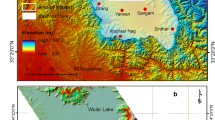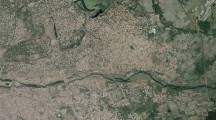Abstract—
Last few decades there are lots of changes in Southeast Asia land cover due to development, industrialization, increasing population, socio-economic activities, and food demands. This research work analysis the maximum likelihood supervised classification approach for Southeast Asia land cover mapping and changes at 30m resolution from 2010 to 2019 using Landsat 8 OLI (Operational Land Imager) satellite data. The resulted maps cover eight land cover classes as barren land, cultivated, developed (built-up area), forest, grassland, shrubland, water, and wetland in Myanmar, Laos, Vietnam, Thailand, Cambodia, and North Malaysia Southeast Asia countries with very high accurate informative information. The resulted maps and information in this paper are very useful to researchers, regional to a national and international level decision and policy makers for sustainable development, fortification of natural resources at the same time protection of fragile eco-environment in Southeast Asia so that they will utilize in future.
Similar content being viewed by others
REFERENCES
Boori, M.S., Choudhary, K., Paringer, R.A., and Evers, M., Food vulnerability analysis in the central dry zone of Myanmar, Comput. Opt., 2017, vol. 41, no. 4. https://doi.org/10.18287/2412-6179-2017-41-4-552-558
Fox, J. and Vogler, J.B., Land-use and land-cover change in Montane Mainland Southeast Asia, Environ. Manage., 2005. https://doi.org/10.1007/s00267-003-0288-7
Miettinen, J., Shi, C., Tan, W.J., and Liew, S.C., 2010 land cover map of insular Southeast Asia in 250-m spatial resolution, Remote Sens. Lett., 2012. https://doi.org/10.1080/01431161.2010.526971
Boori, M.S., Choudhary, K., Kupriyanov, A., Sugimoto, A., and Evers, M., Natural and environmental vulnerability analysis through remote sensing and GIS techniques: a case study of Indigirka River basin, Eastern Siberia, Russia, Proc. SPIE, 2016, vol. 10005. https://doi.org/10.1117/12.2240917
Melendez-Pastor, I., Navarro-Pedreño, J., Koch, M., and Gómez, I., Multi-resolution and temporal characterization of land-use classes in a Mediterranean wetland with land-cover fractions, Int. J. Remote Sens., 2010. https://doi.org/10.1080/01431160903349065
McCabe, M.F., Miralles, D.G., Holmes, T.R., and Fisher, J.B., Advances in the remote sensing of terrestrial evaporation, Remote Sens., 2019, vol. 11, no. 9.
Stoian, A., Poulain, V., Inglada, J., Poughon, V., and Derksen, D., Land cover maps production with high-resolution satellite image time series and convolutional neural networks: adaptations and limits for operational systems, Remote Sens., 2019. https://doi.org/10.3390/rs11171986
Boori, M.S., Choudhary, K., Kupriyanov, A., and Kovelskiy, V., Urbanization data of Samara city, Russia, Data Brief, 2016, vol. 6. https://doi.org/10.1016/j.dib.2016.01.056
Klemas, V.V., Coastal and environmental remote sensing from unmanned aerial vehicles: an overview, J. Coastal Res., 2015. https://doi.org/10.2112/jcoastres-d-15-00005.1
Valderrama-Landeros, L., Flores-de-Santiago, F., Kovacs, J.M., and Flores-Verdugo, F., An assessment of commonly employed satellite-based remote sensors for mapping mangrove species in Mexico using an NDVI-based classification scheme, Environ. Monit. Assess., 2018. https://doi.org/10.1007/s10661-017-6399-z
Lavreniuk, M.S., Skakun, S.V., Shelestov, A.J., et al., Large-scale classification of land cover using retrospective satellite data, Cybern. Syst. Anal., 2016, vol. 52, p. 127. https://doi.org/10.1007/s10559-016-9807-4
Eugenio, F., Marcello, J., and Martin, J., High-resolution maps of bathymetry and benthic habitats in shallow-water environments using multispectral remote sensing imagery, IEEE Trans. Geosci. Remote Sens., 2015. vol. 53, no. 7, pp. 3539–3549. https://doi.org/10.1109/TGRS.2014.2377300
Hansen, M.C. and Loveland, T.R., A review of large area monitoring of land cover change using Landsat data, Remote Sens. Environ., 2012. https://doi.org/10.1016/j.rse.2011.08.024
CONFLICT OF INTEREST
The authors declare that they have no conflicts of interest.
Funding
This work was partially supported by the Ministry of education and science of the Russian Federation in the framework of the implementation of the Program of increasing the competitiveness of Samara University among the world’s leading scientific and educational centers for 2013–2020 years; by the Russian Foundation for Basic Research grants (# 15-29-03823, # 16-41-630761, # 17-01-00972, # 18-37-00418), in the framework of the state task #0026-2018-0102 “Optoinformation technologies for obtaining and processing hyperspectral data”.
Author information
Authors and Affiliations
Corresponding authors
About this article
Cite this article
Mukesh Singh Boori, Choudhary, K. & Kupriyanov, A. 2019 Land Cover Map of Southeast Asia at 30 m Spatial Resolution with Changes Since 2010. Opt. Mem. Neural Networks 29, 257–262 (2020). https://doi.org/10.3103/S1060992X20030091
Received:
Revised:
Accepted:
Published:
Issue Date:
DOI: https://doi.org/10.3103/S1060992X20030091




